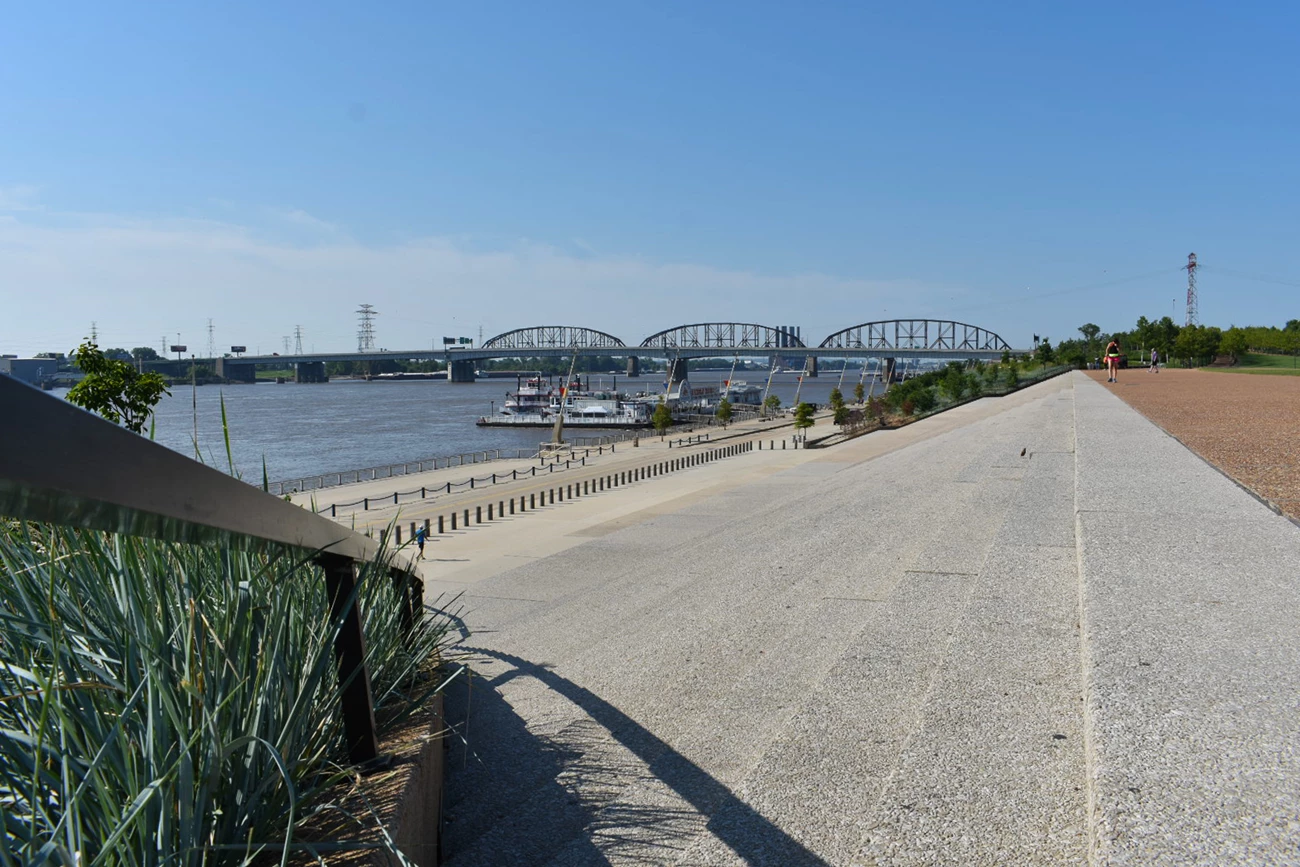Last updated: December 17, 2019
Article
National Expansion Memorial Cultural Landscape

NPS / M. Tack
The Saarinen/Kiley design was selected through an architectural competition organized by the Jefferson National Expansion Memorial Association (JNEMA) and National Park Service at the end of World War II. Originally, proponents of Jefferson National Expansion Memorial project envisioned it to honor President Jefferson, commemorate westward expansion, and support riverfront revitalization. The Gateway Arch construction concluded in 1965. The landscape design was implemented in several phases with the majority of development completed by 2003. After the completion of the Arch, the site grew in popularity as a tourist destination and the monument became an icon of St. Louis.

NPS / L. Edwards
The National Park Service manages Gateway Arch National Park and an adjacent historically significant property known as the Old Court House. An inholding property, the Parish of St. Louis – also referred to as the Old Cathedral – was completed in 1853 before construction of the monument and is owned and managed by the Archdiocese of St. Louis.
Landscape Description
The National Expansion Memorial landscape consists of 91 acres to the west of the Mississippi River. Leonor K. Sullivan Boulevard along the Mississippi River delineates the eastern site boundary and the depressed Interstate 70 defines the majority of the western boundary. A 2017 extension over Interstate 70 provides pedestrian access to Luther Ely Smith Park and the Old Courthouse, site of the landmark Dred Scott case. The extension reinforces the original vision of an axial relationship between the courthouse and arch. The underground visitor center and museum containing the Arch tram entrance also lies on this axis. The tram ride to the top of the Arch is a popular visitor activity that allows for a bird’s eye view of the landscape.

NPS / L. Edwards
Gateway Arch National Park has integrity in design, location, materials, workmanship, setting, feeling, and association. The site has the ability to convey its historical significance, as both a memorial and major designed landscape of the NPS. The landscape’s current and historic location in St. Louis strongly contributes to its integrity related to the memorialization of westward migration. The purpose for its creation corresponds to the city itself. Gateway Arch National Park’s other area of significance – its design merit as a work of two recognized masters in their professions — is upheld by attentiveness to the original Saarinen/Kiley design intent. Although some features were not constructed as designed and compatible substitution of plant material occurred, the overall design concept was realized.
Historic Use
After the establishment of St. Louis as a French fur-trading post in 1764, the village continued to grow into a thriving town. St. Louis’ geographic centrality and proximity to the confluence of the Missouri and Mississippi Rivers made it an ideal hub for steamboat and river commerce. Following President Thomas Jefferson’s 1803 Louisiana Purchase, St. Louis also served as a prominent departure or “jumping-off” point in westward migration. Although the Lewis and Clark Expedition did not begin in St. Louis, it sourced supplies from the city and returned to it in 1806. In 1822, St. Louis was incorporated as a city.
By the late 19th century river commerce declined in favor of rail transportation, which resulted in the deterioration of the St. Louis riverfront. The riverfront memorial proposal, championed by attorney Luther Ely Smith, intended to revitalize the riverfront and commemorate President Jefferson and westward expansion. After the proposal’s favorable reception in 1933 by St. Louis Mayor Bernard Dickmann and local leaders, the Jefferson National Expansion Memorial Association (JNEMA) formed to develop plans and secure funding. In 1935, President Franklin D. Roosevelt signed an executive order which enabled the Secretary of the Interior to develop the memorial, with funds allocated by Congress, and to establish the site location. Early planning studies conducted by the NPS identified buildings worthy of preservation. These included the Old Courthouse and the Old Cathedral. Issues related to land acquisition and funding delayed the project until the end of World War II. In January 1945, JNEMA formally announced an architectural competition for the memorial design.

NPS / M. Tack
The jury assessment said of the design: “It tends to have the inevitable quality of a right solution. The monument suggests the historic past of St. Louis as the Gateway to the West. It is large in scale, yet does not dwarf other structures, and by its very form is sympathetic with the Old Courthouse dome.” The 1959 NPS Master Plan for the memorial adapted the Saarinen/Kiley design and groundbreaking ceremonies occurred on June 23, 1959. Construction of the Gateway Arch was completed on October 28, 1965. Landscape development occurred in phases with walkway and Rosehill ash tree installation in 1972. The last major construction project, the grand staircase, was completed in 2003. Although less than 50 years old at the time of its evaluation, the Arch was listed on the National Register of Historic Places for its “exceptional importance” and designated as a National Historic Landmark.

Balthazar Korab collection, Library of Congress
Quick Facts
- Type of Landcape: Historic Designed Landscape
- National Register Level of Significance: National
- National Register Criteria: A, C
- Period of Significance: 1947-1986
- National Historic Landmark
Landscape Links
- Jefferson National Expansion Memorial Cultural Landscape Report
- National Register of Historic Places: Gateway Arch (Missouri National Historic Landmarks Finding Aid)
- Library of Congress: Jefferson National Expansion Memorial, Historic American Landscapes Survey (HALS MO-6)
- Library of Congress: Jefferson National Expansion Memorial, Historic American Engineering Record (HAER MO-40)
- More about NPS Cultural Landscapes
Tags
- gateway arch national park
- gateway arch
- jefferson national expansion memorial
- landscape architecture
- eero saarinen
- dan kiley
- designed landscape
- staircase
- monument
- modern style
- westward expansion
- st. louis
- engineering
- design competition
- mississippi river
- london planetree
- national historic landmark
- mwr
- cultural landscape
- profile



